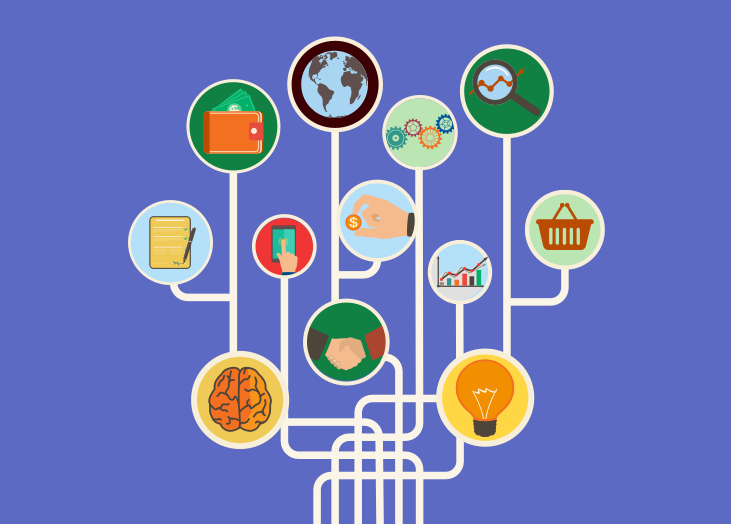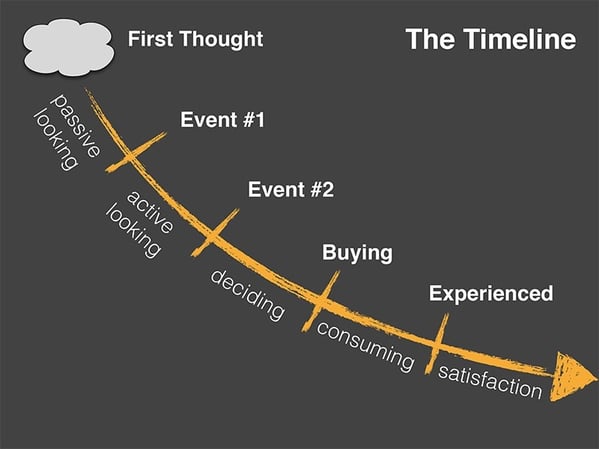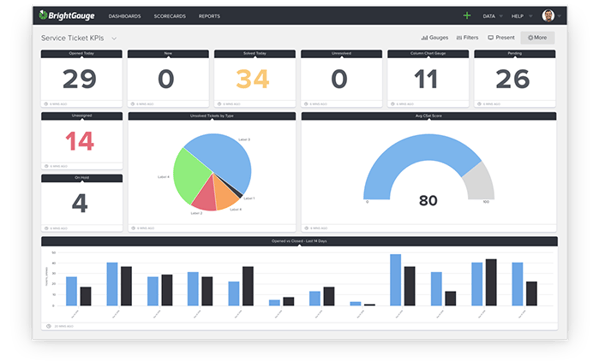The Jobs We Are Hired For

What do you think of when you hear the word ‘job’? Probably a situation where you perform a specific task and earn a paycheck for it, right?
There’s a different definition for ‘job’ and it can radically transform your business approach, making you more laser-focused and maybe more successful. It has to do with what life benefit your customer is looking to gain from using your service. More on this ahead.
What about ‘marketing strategy’? What does that involve? Do you typically create a strategy based on target demographics? A buyer’s persona? As direct competition to a similar service that’s already being packaged by someone else? Do you focus on the service attributes itself?
If you’re nodding your head, you’re not alone. Traditionally, we’ve been taught to look at marketing from this perspective. A lot of companies get their start by looking at an existing product or service and deciding “oh, we can do that better”.
But what if we’ve been taught wrong? Another perspective exists and there’s a strong argument out there for changing your strategy.
A different approach to marketing
We’re talking about wholly shifting your focus to the customer’s emotions. What is the user’s situation? How can your service help them make progress in their lives? What job does the customer actually need your product or service to do for them?
The argument is the theory of Jobs to Be Done (‘job’ meaning the progress a person is looking to make). It is not a new theory. It’s been documented in many books like a favorite of ours, Competing Against Luck, by Clayton M. Christensen. It has been applied by successful companies like Uber, Unilever, and Deseret News. Yet, many people are still confused by or unaware of it.
To help put this theory into perspective, check out the commonly cited ‘milkshake theory’:
At BrightGauge, we like this simplistic approach. While a little difficult to put into practice, we’ve found it helpful to look into how other companies are answering to the jobs their customers are hiring their services to do for them.
Start by talking
If you’re in the process of identifying the needs of your own customers, you may be asking where should I start? The answer is so obvious that it almost feels wrong.
The best place to start is to talk to current customers. Ask brand new users what prompted them to make the switch from another service to yours. Don’t neglect recently churned customers - ask what caused them to leave. More likely than not, you’ll discover some incredibly helpful insights. You may even find your product or service is being used in different ways than you intended, which is not a bad thing! Quick example: Uber may have been started to help passengers have a great experience while getting from point A to point B, but the founders probably didn’t think some would use it as an alternative to owning a car.
When talking to your users, it’s pretty important to get down to small, seemingly insignificant details. If you ask John why he hired an Airbnb rental over a hotel room and he answers, “it was a good price”, you can’t stop there. The fair cost is not the reason John is making progress in his life. What emotional value does Airbnb bring to John? With a little probing, you’d be able to discover that his true underlying need was to feel like he was actually living in the city he was visiting. He wanted to feel at home and Airbnb could do that job better than any hotel room.
Before talking to customers, it might help to understand the typical timeline in a buyer’s decision process:

Consider the ‘consideration set’
While you’re talking to customers, think about the emotional value your product or service brings. Keep the ‘consideration set’ in mind as you formulate new ideas for improving your service. That is, the other products that compete with your product.
In John’s example, you might be tempted to think that all other Airbnbs or hotels in the market are the only existing competitors. Not true. Remember what he hired Airbnb to do (feel at home in a foreign city). Instead of an Airbnb, John could have hired a friend’s couch, leased an apartment, or done nothing at all. Conversely, he could fire his current home and move to the new city (kinda drastic, but not impossible).
Don’t fall into the trap of believing you’ve got a service with zero competitors. You have to ask yourself if it’s really such a good thing to be on your own in the market. Is that an indication that your product is not a right fit? A little healthy competition is a good sign of future growth opportunities.
It can be easy to think of products and services that are similar to your own, but it takes more effort to identify the less obvious competitors. However, this effort can lead to big rewards.
The 5-Hour Energy Story
Manoj Bhargava was perusing the energy drinks available at a tradeshow he was attending, in hopes of finding a pick-me-up. He realized the products on the shelf were too big - he wasn’t thirsty enough to consume a large energy drink. Also, he also didn’t want the extra sugar and junk commonly found in those drinks.
He dreamt of a healthier and much smaller energy booster. When thinking about where in the supermarket to place it, he didn’t think it made sense to place it next to sodas, or water bottles, or other large drinks because customers needed a boost, not a thirst quencher.
Instead, Manoj thought of the check-out area. Customers needed something convenient, quick, and that would help them have a productive day. Out of those needs, 5-Hour Energy was created. Chock full of vitamins and less than 3 ounces, it’s an effective grab-and-go solution. So effective Manoj is now a billionaire.
Had Manoj thought to place 5-Hour Energy alongside Gatorade (an obvious competitor), the story may have turned out differently.
Putting on a BrightGauge lens
We are constantly exploring new ways to help our customers improve their lives through the use of BrightGauge. Through trial and error, plus a lot of talking to customers, we’ve come to understand that we’re here to help them easily see all their KPIs, impress their clients, and motivate their team. This all makes a really big difference to a lot of people’s businesses. Our work isn’t done though.

Figuring out your product/service and the emotional value it delivers to people is just one piece of the puzzle. How do we apply this same frame of thought to other areas of business, like marketing?
Base your communication on emotions, not features
Every marketing strategy involves a lead generation campaign of some sort. If you’re not generating leads, you’re not gaining customers. No customers means no business.
In today’s age of digital marketing, there are many tactics to choose from, ranging from pay-per-click (PPC) to retargeting campaigns to personalized emails. The method you choose is not as important as the message you put out there.
So many times, you see ads that try to lure leads in by screaming “FREE Trial!” or “Lose 10 Pounds in 1 Day” (a.k.a., a totally unrealistic promise). Your customers are smarter than that. They will recognize click bait when they see it. With all the screens in their lives flooded with messages like that, how do you expect to stand out?
Instead of focusing on shiny-gimmicky features, talk to customers about how your service will help them. Bring their emotions into the picture, because that’s what they will connect with.
We like what Snickers has done. They’re not marketing themselves as “the best chocolate ever”. That’s just an unsubstantiated and very subjective claim. Their slogan is, “Hungry? Why Wait?”. First of all, everyone can relate to being hungry hangry. It makes you tired, cranky, moody, whatever. So, instantly a connection has been made. Secondly, they’re alluding that a Snickers can replace a meal. They’re helping their customers by keeping them full enough to get on with their activities and to last until dinnertime. Suddenly, Snickers is competing with a sandwich, and they become the best-selling candybar on the market. Genius.
How we provide value through facetime
We mentioned three key ways that BrightGauge helps customers make improvements on a daily basis. Working off of those insights, we realized that not every new customer is seeking the same solution. So, how do we communicate in a way that’s resourceful and truly valuable?
We ask questions and we do it in person.
BrightGauge is simple to use, but our users’ needs can get complicated. We like to take a hands-on approach to helping them find solutions. Through Data Driven Workshops or Customer Site visits, we ask our customers what they are looking for. Based on their answers, we tailor our demonstrations to provide the most value to each individual. For example, if a customer mentions that they are looking for a way to show their worth to their clients, we know we can help them gain more business through our reporting tool, which is a powerful way to build trust and credibility with clients.
It’s more efficient for them because they’re getting comprehensive and valuable answers and they’re able to dive deep into our product. It’s helpful for us because face-to-face time goes a long way in building lasting relationships with quality customers. Plus, it’s fun for us!
Take a new approach to your business plan
If you’re trying to think of the next “big idea” or if you’re finding ways to strike gold, dial it back a bit. Take time to ask yourself “how can I make people’s lives better?” instead of “how can I create a super cool service?”. See where you can inject an extra bit of positivity into someone’s day, and hopefully, make them feel like a superhero for their team.
It’s not really about reinventing the wheel here. It’s truly about making a positive difference in people’s daily lives.
Consider the pain points that would drive someone to hire your service and fire the one they had already been using. Put yourself in the customer’s shoes and imagine the life events that cause you to take action in your own job.
Remember:
- Job doesn’t always mean employment. It can mean progress being made in one’s life
- Consider a customer’s emotional, functional, and social situation - context and circumstance matter
- Your existing competitors may be in an entirely different product category
- Always use a lens of “how can I help my customer?” and not “look, what I offer is so pretty!”
There’s a whole lot to learn about the Jobs to Be Done (JTBD) theory and, if anything, it’s an interesting lens with which to view marketing. We’ve found this site and this site to be helpful resources in learning more about this theory, but our ears are always open! How have you applied JTBD to your world?
Free MSA Template
Whether you’re planning your first managed services agreement, or you’re ready to overhaul your existing version, we've got you covered!


